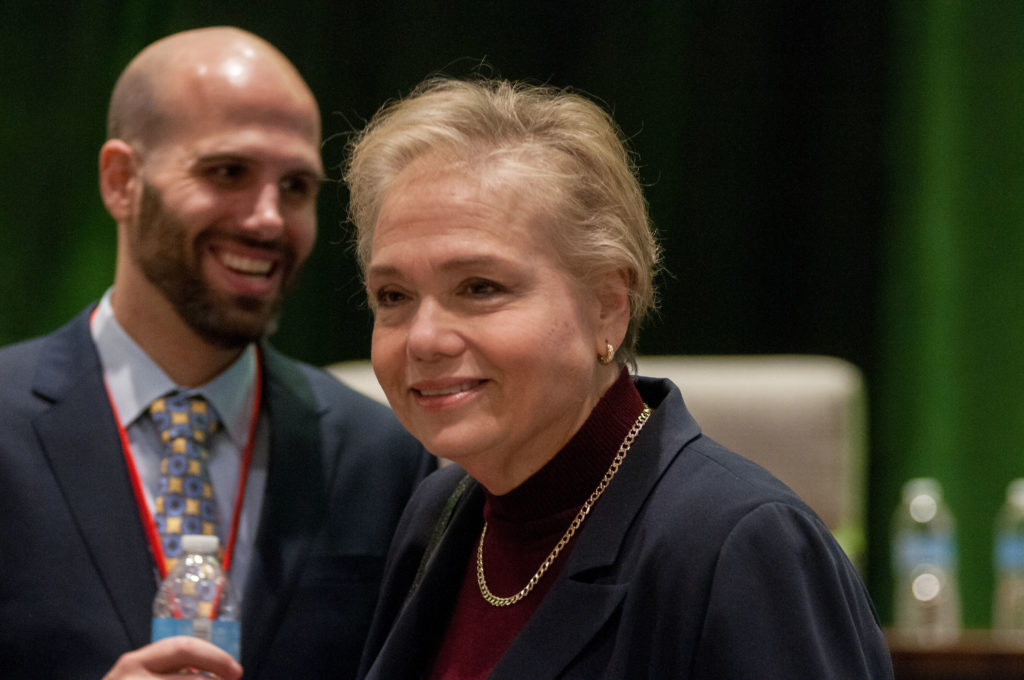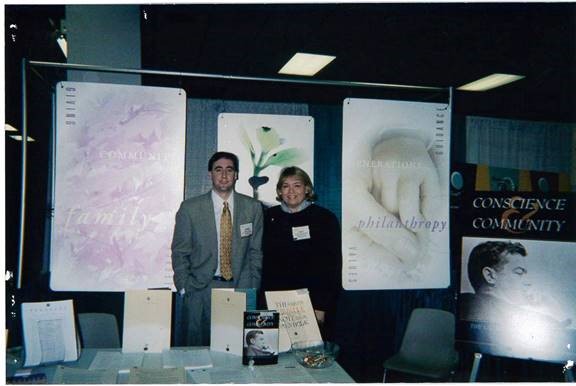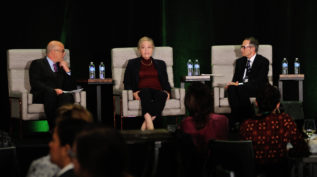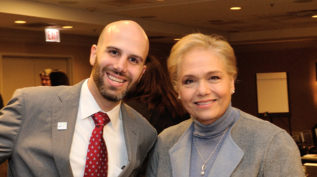The Promise of Even Greater Possibilities
Almost 25 years ago, the idea for the National Center for Family Philanthropy was sparked by the inspiration of a small group of giving families. The seed they planted has grown into a remarkable family tree, taking root and flourishing with the participation of countless more families and even greater inspiration.

What distinguishes giving families are the dual goals they bring to their philanthropic giving: goals for charitable purpose and goals for family participation. What unites them all is a very personal passion, a commitment to the legacy of their families’ values and vision and a commitment to philanthropic excellence.

Jason Born and Ginny Esposito at the first NCFP booth
As I mentioned at the recent National Forum on Family Philanthropy, I began my service to family philanthropy by asking dozens of families why they were giving together. Inevitably, they said they wanted to give back. When I pressed on, asking what they wanted to accomplish, they told me they hoped to make a difference. My much younger, naïve self was frustrated by these responses. What did they mean? How could I build a program of services and resources based on giving back and making a difference? More families and more wisdom helped me realize that giving back is all about gratitude. Making a difference is about optimism. Gratitude and Optimism. Not bad motivations for a family giving program. Not bad motivations for an organization that hoped to serve giving families.

David Dodson, Ginny Esposito, and Ira Hirschfield
As I think back about the extraordinary change that has occurred since the idea of the National Center was first broached nearly a quarter century ago—and all of the ways that our support for the field of family philanthropy has changed—it might be tempting to try to make sense of all of that change and spend some time speculating about the change to come. It may be a natural resistance to taking the expected path (contrariness?), but I believed it would be intriguing and, hopefully, more compelling to ask a different question: What should stay the same?
What are the National Center’s North Stars?
What are the constants of our work—what is our North Star? What is the spirit of family philanthropy and what does that say about the soul of the organization that serves that field? I look forward with great excitement to following and understanding the trends and strategies of the future. Here are a few initial reflections from the National Center’s soon-to-be-Senior Fellow on some of the most important constants of family philanthropy.
- The Heart of Family Philanthropy: Love
At the core of every family charitable commitment is the love for family and a passion for something larger than the family. Both drive a commitment to community, whether that is a community focused on place or a community of concern. Some worry that the emotions attendant to family giving give it a volatility that competes with the more dispassionate thinking necessary to making wise charitable investments. Ambassador James Joseph, former CEO of the Council on Foundations, once wrote, “Pascal said that the mind builds walls and the heart jumps over them. To be in philanthropy is to refuse to accept the heart and the mind as antagonists.” Another of my mentors, foundation trustee Paul Ylvisaker said, “Follow both routes to understanding, the compassionate as well as the analytical. No one can comprehend the universe who does not understand and care for the sparrow.”
- The Dream of Family Philanthropy: Shared Values and Vision
In the most purposeful and productive family philanthropies, shared values and vision provide both an anchor and springboard for the shared work. Individual differences based on generation or geography, politics or preferences take a back seat to the collective dream of making the world a better place. A sense of stewardship prevails over any individual sense of ownership or prerogative.
- The Spirit of Family Philanthropy: Renewal
It is not only the field of family philanthropy in great flux but the families themselves. Each founder understands that the decision to involve family members in the process—perhaps over generations—carries with it the inherent need for evolving and renewing. The family philanthropy that thrives is one that embraces this concept and the work necessary to achieving ongoing vitality. Like families themselves, their philanthropic organizations grow, change, and experience triumph, trauma, and tragedy. Renewing the values and vision of family philanthropy regenerates the spirit and sustains the giving over time.
- The Soul of Family Philanthropy: Personal Commitment to a Public Good
For decades, practitioners and pundits have wondered how a tradition, based largely, if not exclusively, on family legacy makes sense in a society based on democratic principles. For families of wealth, philanthropy provides a vehicle by which a matter of chance—the fact that people are related to one another—becomes a considered choice. It provides the means by which private good can be turned to the public benefit. Family philanthropy is one of the points at which the principles of individual well-being and the common good do, in fact, merge.
- The Privilege of Family Philanthropy: Joy
Family philanthropy mirrors family life itself in that it encompasses triumph and tragedy. We look for commonality and sometimes find consternation. But moments of joy abound and they lift us to greater effort and provide sustenance on the occasional lean day. Joy is found in the privilege of supporting an extraordinary grantee partner. It’s in seeing your family members for something you might have missed: how thoughtful they are in navigating troubled times; how dedicated and knowledgeable they are to the causes you fund. It is making connections across generations and family branches. It’s in welcoming others into your deliberations to add expertise, experience, and a fresh perspective. It’s in the lifelong learning good giving requires and affords. Lucile Packard once remarked that she wanted to communicate to her children the joy of participating in philanthropy. She knew they would have many opportunities to learn of community concerns and assets. If philanthropy was to be sustained over time, what couldn’t be overlooked, she understood, was the power, the inspiration, and the encouragement of the joy to be found in doing this extraordinary work.
Gratitude and Optimism
As I step down from my role as President I find myself exactly back where I began. Filled with gratitude for all I have experienced, learned and felt. Gratitude for every family member who trusted me with a story, a problem, or a willingness to help another family in need. Gratitude for those who trusted the National Center by attending a program, calling a member of our staff, reading a publication, or consulting a study. Gratitude for every board and staff member that brought passion, initiative, and encouragement to our shared commitment.

Nick Tedesco and Ginny Esposito
Finally, I am overwhelmingly optimistic about all that is to come. Under the distinguished leadership of the National Center’s amazing Board of Directors, with the talented and dedicated Nick Tedesco at the helm, the efforts of the extraordinary staff who have been my colleagues and friends, the Friends of the Family, funders, and other sponsors and supporters, how could I be anything but optimistic? Well, I am and even more so because I have met so many of you—inspiring and generous donors, family members, practitioners and advisors—committed to excellence in family philanthropy.
At this special season of Thanksgiving, please accept my heartfelt gratitude for the gift of doing work that has brought me joy and inspiration every day. And know that optimism infuses my hopes for the wondrous things yet to come.
